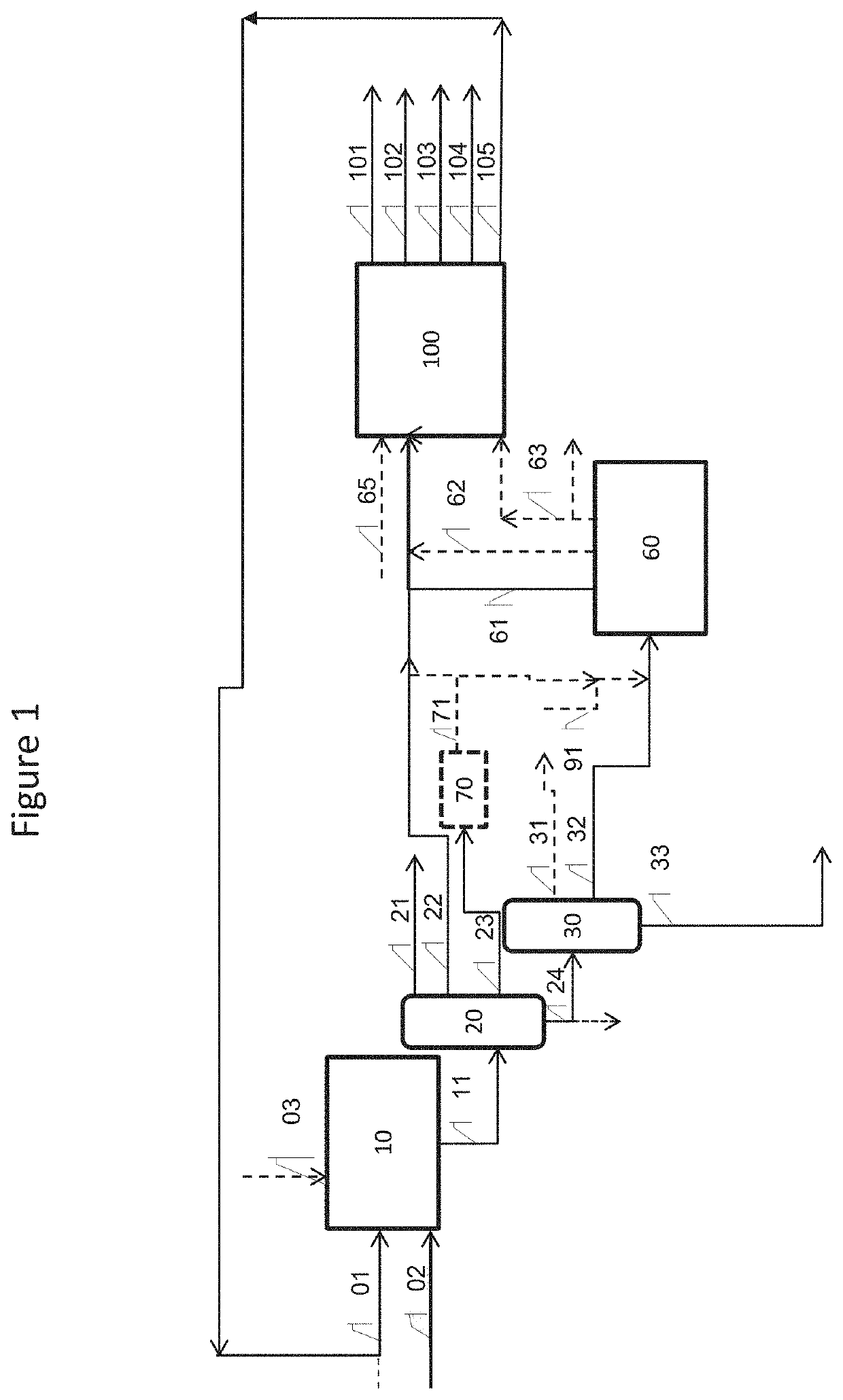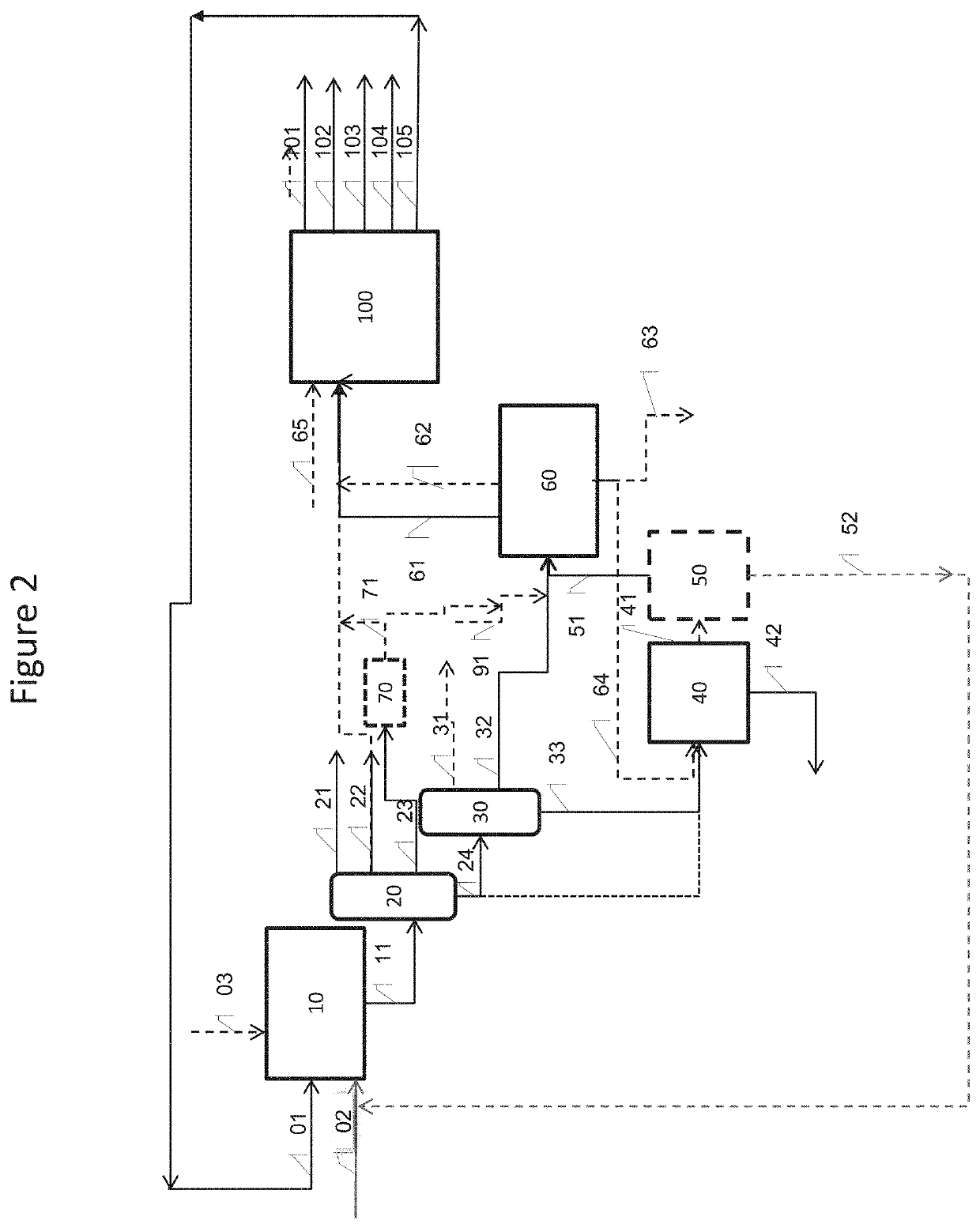Process for converting a feedstock containing pyrolysis oil
a technology of pyrolysis oil and feedstock, which is applied in the direction of hydrocarbon oil treatment, thermal non-catalytic cracking, and solvent de-asphalting, etc., to achieve the effect of reducing equipment fouling, reducing coke precursors and sediment formation, and reducing equipment fouling
- Summary
- Abstract
- Description
- Claims
- Application Information
AI Technical Summary
Benefits of technology
Problems solved by technology
Method used
Image
Examples
example 1
[0220]This non-limiting example concerns an embodiment of the invention in accordance with FIG. 1. More particularly, it details the hydroconversion step a) according to the invention, and the type of feedstocks used according to the invention. An ebullated-bed hydroconversion unit corresponding to unit 10 of FIG. 1 treats a first feedstock consisting of pyrolysis oil obtained from a steam cracking unit treating naphtha and a second vacuum residue feedstock obtained from the distillation of a crude oil, having the properties detailed in Table 1 below. The two feedstocks are fed, in accordance with the invention, separately in the first hydroconversion reactor. The pyrolysis oil (the first feedstock) has a feed temperature T1 of about 100° C., and the vacuum residue (the second feedstock) has a feed temperature T2 of about 300° C. It should be noted that the pyrolysis oil described below may originate from step g) according to the invention or from any independent steam cracking unit...
example 2
[0229]The feedstocks used in this example are identical to those of Example 1. They are used in a process according to one embodiment of the invention, as described in FIG. 1.
[0230]The feedstocks are treated in an ebullated-bed hydroconversion unit 10 as described in Example 1, and under the same operating conditions, without addition of catalytic precursor to the feedstock. The two feedstocks are fed separately. The products of the unit are treated in the same fractionation section.
[0231]The fixed-bed hydrocracking unit 60 treats the mixture of vacuum gas oil fraction 31 and of diesel fraction 23 produced. The hydrocracking unit 60 is operated in two stages under the operating conditions detailed in Table 4.
[0232]The vacuum residue 33 obtained from the hydroconversion unit is used as fuel oil. The hydrocracking unit produces an effluent which is sent to a fractionation section producing a naphtha fraction 61 and a gas oil fraction 62, which are sent to the steam cracking unit 100, ...
example 3
[0238]The feedstocks used in this example are identical to those of Examples 1 and 2. They are used in a process according to one variant of the invention described in FIG. 2.
[0239]The feedstocks are treated in a deep hydroconversion unit 10 as in Example 1, and under the same operating conditions, without addition of catalytic precursor to the feedstock. The two feedstocks are fed separately to the first reactor. The products of the unit are treated in the same fractionation section. The hydrocracking unit 60 and the steam cracking unit 100 are operated by treating the same streams and under the same operating conditions as in Example 2, and produce the same effluents.
[0240]A unit for deasphalting with solvent in two steps (a first step 40 and a second step 50) treats the vacuum residue 33 obtained from the hydroconversion unit 10. The light deasphalted oil fraction 51 produced is sent to the hydrocracking unit 60 as a mixture with the vacuum gas oil fraction 31 and the diesel frac...
PUM
| Property | Measurement | Unit |
|---|---|---|
| boiling point | aaaaa | aaaaa |
| feed temperature T2 | aaaaa | aaaaa |
| feed temperature T2 | aaaaa | aaaaa |
Abstract
Description
Claims
Application Information
 Login to View More
Login to View More - R&D
- Intellectual Property
- Life Sciences
- Materials
- Tech Scout
- Unparalleled Data Quality
- Higher Quality Content
- 60% Fewer Hallucinations
Browse by: Latest US Patents, China's latest patents, Technical Efficacy Thesaurus, Application Domain, Technology Topic, Popular Technical Reports.
© 2025 PatSnap. All rights reserved.Legal|Privacy policy|Modern Slavery Act Transparency Statement|Sitemap|About US| Contact US: help@patsnap.com



